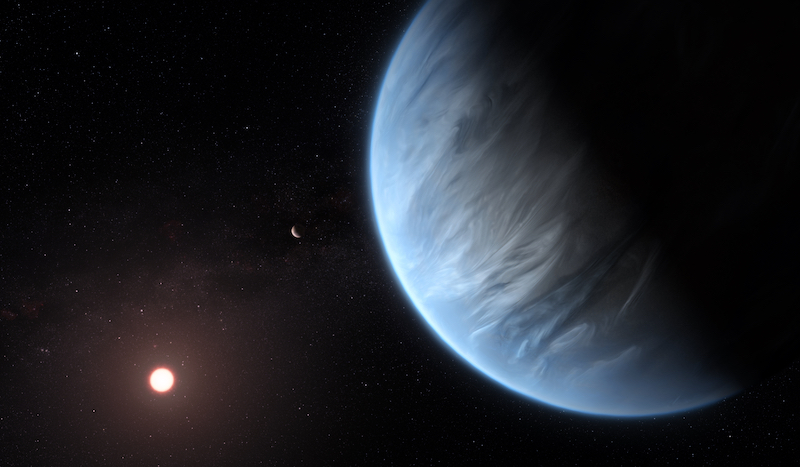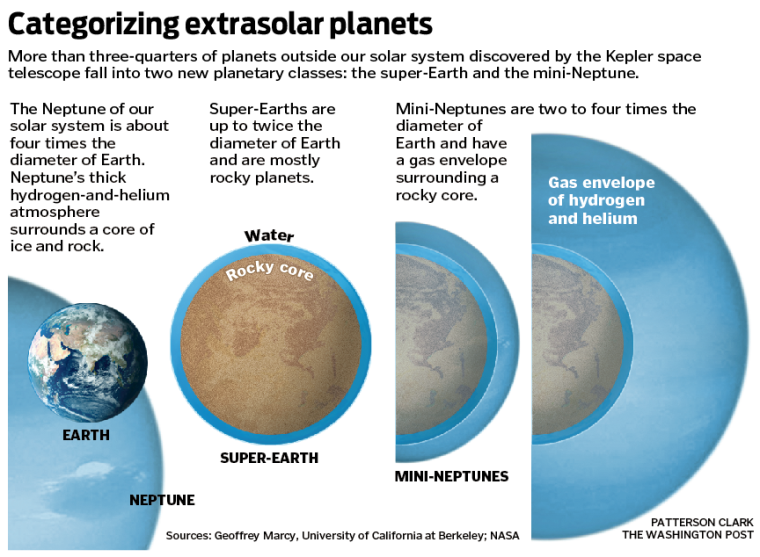
Can giant exoplanets such as super-Earths or even mini-Neptunes be habitable? There’s currently a lot of debate about that question, but new findings about one such world suggest that some of them might indeed be able to support life. A research team from the University of Cambridge has announced that K2-18b, a planet a bit more than twice the size of Earth, could have liquid water and habitable conditions, even though it’s been classified as a mini-Neptune.
The peer-reviewed findings were published in The Astrophysical Journal Letters on February 27, 2020.
Water vapor had previously been detected in the atmosphere of K2-18b, as announced last September, but because the planet was classified by most scientists as a mini-Neptune, it was regarded to be very unlikely to be habitable. Planets like Neptune have deep hydrogen atmospheres and no real solid surface. Nikku Madhusudhan from Cambridge’s Institute of Astronomy, who led the research team, said in a statement:
Water vapor has been detected in the atmospheres of a number of exoplanets but, even if the planet is in the habitable zone, that doesn’t necessarily mean there are habitable conditions on the surface. To establish the prospects for habitability, it is important to obtain a unified understanding of the interior and atmospheric conditions on the planet, in particular, whether liquid water can exist beneath the atmosphere.


K2-18b is about 2.6 times the radius and 8.6 times the mass of Earth. It is 124 light-years away, orbiting within the habitable zone – the region where liquid water could exist – of a red dwarf star. There is also a second candidate planet closer to the star, K2-18c, but it has not been confirmed yet.
On mini-Neptunes, a thick hydrogen atmosphere is thought to surround a watery layer that then surrounds a rocky iron core. But under such conditions, the temperatures would be too high, and the water would be under too much pressure, for life to survive. This is similar to why Neptune or Uranus type worlds are uninhabitable, at least by earthly life standards, having deep atmospheres with crushing pressures, no solid rocky surface and no liquid water.
Given K2-18b’s large size, it has been assumed that it is more like a mini-Neptune than a super-Earth, which typically are a bit smaller, but still at least twice as large as Earth.
But that assessment might be changing a bit, if the researchers are right.
They found that K2-18b’s hydrogen atmosphere might not be too thick after all, and the water layer might actually be habitable, perhaps more like oceans on Earth. The researchers used the mass and radius of the planet, as well as previous observations of the atmosphere, to make a better determination of the composition and structure of both the atmosphere and deep interior. Detailed numerical models and statistical methods were used to help explain what conditions are actually like on this distant world.

The computer models showed that a range of conditions are possible in the planet’s interior. Those models used known atmospheric properties as constraints on which conditions are the most plausible. The potential habitability rests on just how extensive the hydrogen atmosphere is. According to study co-author Matthew Nixon at the Institute of Astronomy:
We wanted to know the thickness of the hydrogen envelope, how deep the hydrogen goes. While this is a question with multiple solutions, we’ve shown that you don’t need much hydrogen to explain all the observations together.
So what did the researchers find? According to their results, the maximum extent of the hydrogen atmosphere, or envelope, is only 6% of K2-18b’s mass. Some computer models showed it to be even less. The minimum amount of hydrogen is about one-millionth by mass, which is similar to that of Earth’s atmosphere. Under those conditions, the atmosphere would be more like that of a super-Earth, rather than a mini-Neptune.
Moreover, a number of the calculated models would allow for a world with a true ocean, not just a layer of water that is under extreme, unearthly pressure and temperature. In this scenario, the temperature and pressure would actually be similar to those in Earth’s oceans.
There’s another intriguing twist to this, as well. While the researchers did confirm the atmosphere to be composed mostly of hydrogen, with quite a bit of water vapor, as already known, they also found something puzzling. The levels of methane (CH4) and ammonia (NH3) were less than expected. According to the paper, this is evidence of chemical disequilibrium – or non-equilibrium thermodynamics – in the atmosphere, and, maybe, could even point to biological activity as a cause:
Furthermore, our constraints on CH4 and NH3 suggest chemical disequilibrium. Among other possibilities for chemical disequilibrium, e.g., photochemistry, the potential influence of biochemical processes may not be entirely ruled out. Future observations, e.g., with the James Webb Space Telescope (JWST), will have the potential to refine our findings. We argue that planets such as K2-18b can indeed have the potential to approach habitable conditions and searches for biosignatures should not necessarily be restricted to smaller rocky planets.
On Earth, disequilibrium in the atmosphere – larger than normal amounts of oxygen and small amounts of methane – is caused by biological processes, and is a biosignature. For K2-18b however, it should be emphasized that this is just one of several possibilities, given that the planet is still much different from Earth in significant ways. As the paper stated, one other possibility is photochemistry; in this case, the chemical reactions in a planetary atmosphere caused by light or radiation from its star.
If these findings turn out to be accurate, that would greatly increase the number of potentially habitable planets out there, since worlds of this size are rather common.

This new paper is sure to cause some intense debate, much like last September when the water vapor detection was first reported, and most media outlets described K2-18b as a habitable super-Earth, which was misleading and premature.
Upcoming new space telescopes such as JWST and others will be able to analyze the atmospheres of planets like K2-18b and search for possible biosignatures, chemical signatures of life. That will help to determine whether any exoplanets like this, including super-Earths, could actually be habitable.
Bottom line: A new study suggests that the giant exoplanet K2-18b may be more potentially habitable than previously thought.
Source: The Interior and Atmosphere of the Habitable-zone Exoplanet K2-18b











